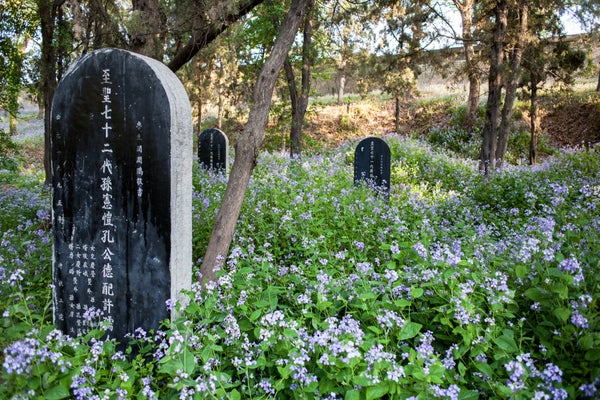Two weeks after the spring equinox, farmers in China’s Hebei province pay a visit to deceased loved ones in tiny graveyards among the vast wheat fields to mark Qingming Jie, an annual festival for remembering ancestors. After burnt offerings turn to ash and the incense smoke clears, these private family graveyards are left largely undisturbed until next year, quietly allowing nature to take its course.
It turns out that such graveyards in crop fields are more than peaceful places for people to pay their respects; they also function as miniature botanical preserves, a new study finds. Even the tiniest burial sites support a diverse array of native plants, helping to conserve patches of relatively untouched habitat in the study area—one of the most heavily farmed regions in China.
“These graveyards are left to their own devices most of the time,” says Jan Axmacher, a University College London conservation biologist and a study co-author. “We were impressed by the uniqueness and diversity of plants. It was quite unexpected.”
On supporting science journalism
If you're enjoying this article, consider supporting our award-winning journalism by subscribing. By purchasing a subscription you are helping to ensure the future of impactful stories about the discoveries and ideas shaping our world today.
Researchers are just beginning to recognize the role of burial places as protectors of biodiversity. In 2015 scientists found rare orchids thriving in cemeteries in Turkey, and another team discovered a variety of medicinal plants in the graveyards of Bangladesh in 2008. And in Ukraine in 2014, ancient burial mounds were found to safeguard the last remnants of Europe’s dwindling steppe grasslands.
In Illinois, cemeteries where early European colonists were buried are sustaining patches of endangered prairie vegetation, which has largely been wiped out by modern agricultural practices. As of December 2020, more than 40 cemeteries are listed in the state’s Natural Areas Inventory for their high-quality prairie and savanna flora. Nearly half of these sites are protected by the Illinois Department of Resources’ Nature Preserves Commission (INPC), which manages ecologically important natural areas and endangered species’ habitats.
“We recognize the value of these cemeteries as time capsules that show a somewhat tainted version of how the landscape looked when European settlers arrived,” says Angella Moorehouse, a natural areas preservation specialist at the INPC, who was not involved in the study. “There are certainly more flower-visiting insects in the cemeteries than in the surrounding crop fields.”
For the new study, Yunhui Liu at China Agricultural University in Beijing and colleagues conducted plant surveys in 199 family graveyards among Hebei province wheat fields. The graveyards ranged in area from two to 400 square meters, with an average of 55 square meters.
The team also surveyed plants in 125 randomly selected non–burial plots in the wheat fields, for comparison. They additionally counted plant species in 30 non–burial field margin areas, to compare the graveyards’ biodiversity with another common habitat type in the region.
Despite their relatively small size, the graveyards were found to be home to a total of 81 native plant species; the non–burial plots in the wheat fields had a total of 34. Even the smallest graveyard in the study, covering just two square meters, hosted 24 plant species. Nearly half of all graveyard plants were important food resources for insect pollinators, with most belonging to Asteraceae, the daisy and sunflower family. By contrast, in the wheat fields only around one third of the native plant species were insect-pollinated.
And even though the field margins contained the same total number of plant species as the graveyards, just over a quarter of these were pollinated by insects. The graveyards also showed a wider variety of species across each site than did the margins. The findings were published in Scientific Reports in January.
With a total of 35 species of flowering plants in each graveyard, such sites could provide a stable home for insect communities that pollinate nearby crops including peaches, apples and pepper plants, Axmacher says. These native flora islands could also be a resource for helpful insects such as carabid beetles, which feed on crop-destroying aphids and thus help protect the surrounding wheat fields.
Many Hebei farmers bury their deceased loved ones in caskets, so it is unlikely that the high number of flourishing plants in the graveyards are linked to the decomposition process, Axmacher says. “It’s really just letting nature get on with things and not touching the area,” he adds.
In contrast to the prairie cemeteries in Illinois, China’s family graveyards are not legally protected or formally recognized for their biodiversity. Their long-term fate is unclear given China’s growing population and the associated push to convert more land into agricultural fields. The new study suggests that losing graveyards to agriculture could threaten or wipe out some of the area’s last remaining native plant communities, cutting off the benefits they supply to the surrounding farmland and other ecosystems, Axmacher says: “That’s potentially quite devastating for biodiversity and it’s not a sustainable way to do agriculture.”
The findings highlight the importance of conserving even the smallest patches of noncrop vegetation in farming areas, says Michal Knapp, an ecologist at the Czech University of Life Sciences Prague. However, he notes that assessing the small plots’ full influence on biodiversity will require a broader research approach.
One way to do this, Knapp says, is to explore the effects that graveyard-dwelling insect, bird and mammal populations have on neighboring arable land. “This could be a way to show that family graveyards really are important for ecosystem functioning and biodiversity,” adds Knapp, who was not involved in the study.
Axmacher hopes the findings encourage farmers and policymakers to preserve graveyards, both for their ecological and cultural value, in areas where industrial agriculture reigns supreme. He concludes: “Any graveyards that are harboring high proportions of native vegetation that has disappeared in the surrounding landscape are of great value and protection-worthy.”
